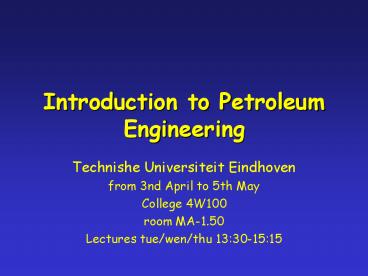Introduction to Petroleum Engineering PowerPoint PPT Presentation
1 / 43
Title: Introduction to Petroleum Engineering
1
Introduction to Petroleum Engineering
- Technishe Universiteit Eindhoven
- from 3nd April to 5th May
- College 4W100
- room MA-1.50
- Lectures tue/wen/thu 1330-1515
2
Week 14
4 - Introduction to petroleum engineering An
overview of production and transportation of oil
and gas structure and equipment will be given.
1 - Energy sources which is the role of oil and
gas A general overview of energy policy and the
energy sources around the world and in the EU.
How oil gas are weighing in the national energy
balance ? How they can be substitute with other
sources ?
2 - Oil and gas market where we are going The
oil gas market is one of the biggest in the
world. Which are the trends in oil demand and
offer ? How gas differs from oil ? which is the
future for the oil gas ?
3
Energy sources which is the role of oil gas
4
Energy sources
- Fossil fuels
- oil
- natural gas
- coal
- Nuclear energy
- Hydro-electricity (Renewable)
- Renewable ? recently introduced
5
Primary energy consumption
6
World regions
Former Soviet Union
Europe
North America
Middle East
Asia pacific
Africa
Central South America
7
Regional consumption 1999
94 oil gas
55 gas
15 Nuclear
40 coal
15 Hydro
8
Energy consumption
Twice in Europe
Berlin wall broken down
9
World by regions - 1999
10
The use of energy...
- Growth little by little as a country is
developing in economy, technology and sociality - its modify in time due to
- structural changes of social and production
systems following the economic development - technical change involved in energy use and
economic activities.
11
...
- Its also different between contries with similar
economical development - Each country is different due to resources in
place, climate, social organization, etc.
12
Energy intensity
- As energy intensity is defined the ratio between
energy consumption and an indicator of activity
related to the energy consumption. - The primary energy intensity of an economic
system is the ratio between primary energy
consumption and its gross domestic product
(GDP). - To compare during time different economic systems
of energy intensity is usual to adopt the GDP at
constat rate, expressed in dollars.
13
Energy intensity istruction for use
intensityf(GDP p.c.)
consumption/population
consumption p.c.
consumption
GDP/population
intensity ------------------
--------------------------- ------------------
GDP
GDP p.c.
consumption p.c.g(GDP p.c.)
14
The three steps in energy intensity evolution
First industrial step
Second step in developing
Advanced industrialisation services
15
Long period energy intensitytechnical change
and leap-frogging
The countries that start industrialisation
process use more advanced techniques than their
predecessors. Thus, the plateau of them is lower
than this of predecessors.
16
Long time energy intensitythe lesson of
industrial countries
Note dollars in purchasing power parity in 1980
Fonte J.M. Martin, Lintensité énergetique de
lactivité economique dans les pays
industrialisés les evolutions de très longue
periode livrent-elles des enseignements utiles?,
Economie et Sociétés, n.4, 1988.
17
Standard energy units and conversion factors
tce tpe bpe b/gpe Nm3 NG 1 tonn. of
coal equivalent (tce) 1 0,646 4,79 0,01312
745 1 tonn. of oil equivalent (tpe) 1,548
1 7,41 0,02031 1153 1 barrel of
oil equivalent (bpe) 0,2988 1,135
1 2,7410-3 155,7 1 barrel per day
of oil equivalent (b/gpe) 76,2 49,230 365
1 5,6810-4 1 metro cubo di gas naturale
equivalente (Nm3 NG ) 1,34310-3
8,6710-4 6,4210-3 1,7610-5 1
1 tonn. of oil equivalent 10
million of kcal
18
Energy consumption and economic development - 1996
19
Primary energy consumption
Eni su dati ENERDATA s.a.
20
Energy consumption by fuel
Eni su dati ENERDATA s.a.
21
Coal consumption
Eni su dati ENERDATA s.a.
22
Coal consumption by sector
Eni su dati ENERDATA s.a.
23
Oil consumption
Eni su dati ENERDATA s.a.
24
Oil consumption by sector
Eni su dati ENERDATA s.a.
25
Gas consumption
26
Gas consumption by sector
Eni su dati ENERDATA s.a.
27
Non conventional sources
Eni su dati ENERDATA s.a.
28
Non conventional by sector
Eni su dati ENERDATA s.a.
29
Energy consumption by final use
Eni su dati ENERDATA s.a.
30
Electricity production
Eni su dati ENERDATA s.a.
31
Electricity production by fuel
Eni su dati ENERDATA s.a.
32
Competitiviness of electricity energy sources
Coal
Fuel-oil
Natural gas
Nuclear
Hydro
(1)
(2)
1) Combined cycle 2) gt500 MW capacity
33
Europe energy system
34
(No Transcript)
35
World by country - 1999
36
Europe by fuel - 1999
37
Energy balance C/P
Consumption 16 Production 8 Import dependency
50
38
Import dependency
Main oil import area Russia, Persian Gulf
region, and North Africa
39
Carbon emissions - 1998
Total emissions 895 Mtons
EU 2.4 tons of carbon per person U.S. average
5.5
Under the December 1997 Kyoto Protocol, the EU is
obligated to reduce its greenhouse gas emissions
8 from 1990 levels (in that year, the EU emitted
913 Mmt of carbon) by 2008-2012. All EU member
states signed the Kyoto Protocol on April 29,
1998. On June 17, 1998, the EU agreed on how it
would meet the 8 reduction. Under this
agreement, different EU member states are
assigned varying degrees of emission cuts,
ranging from a 4 increase in the case of Sweden,
to a reduction of 28 in the case of Luxembourg,
with other countries somewhere in between.
40
Energy cons. vs. GDP
Nederlands Turkey
41
Energy cons. p.c. vs. GDP p.c.
Low efficiency
Mean consumption
High efficiency
42
Efficiency vs. GDP p.c.
The Nederlands
43
Energy cons. p.c. vs. energy intensity

